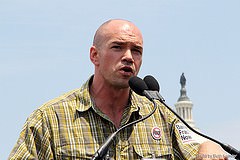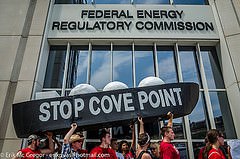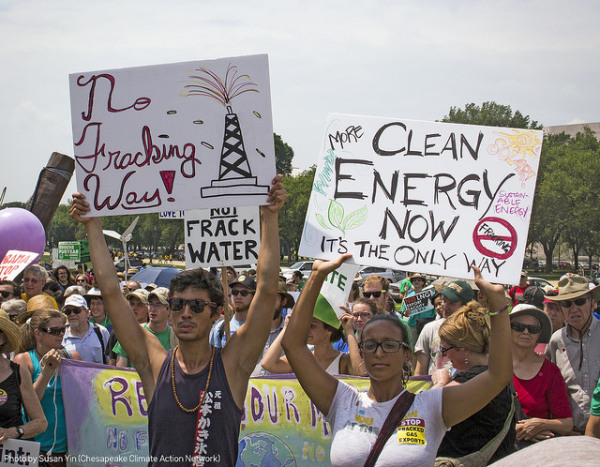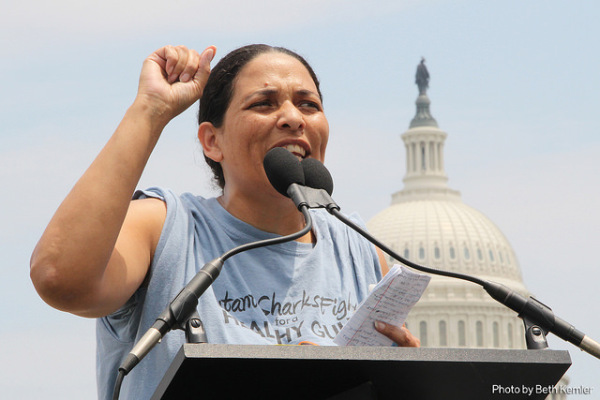But the Sunoco controversy comes as statewide attitudes seem to be shifting against Corbett: The Pennsylvania Supreme Court struck down Act 13’s local zoning controls in December, and the governor now faces bipartisan calls to close a massive budget deficit in part by extracting more from gas producers through a new, higher tax on the value of their gas.
Fight Climate Change: Comment Now on EPA Carbon Rule!
The public comment deadline for the historic Clean Power Plan is now October 16th. The shale gas and oil industry, along with coal and traditional oil interests, are attacking this proposed plan, attempting to undermine and weaken it, with all they’ve got. You can help make history by supporting — and critiquing — the plan using the information below, and the short sample letter at the end, contributed by Ann Dixon.
Carbon Rule: We Can Do Better
By Ann Dixon
President Obama and the Environmental Protection Agency have a Clean Power Plan. When this plan is enacted, it will be the first time in U.S. history that carbon emissions have been regulated! It calls for a 30% reduction in C02 emissions from power plants below the 2005 level. This is significant because one third of domestic greenhouse gas is from power plants. View the entire proposal here.
The EPA’s Clean Power Plan fact sheet reads:
The power sector is a major contributor of CO2 in particular, but also contributes to emissions of sulfur hexafluoride (SF6), methane (CH4), and nitrous oxide (N2O) … The Clean Power Plan will reduce pollutants that contribute to the soot and smog that make people sick by over 25 percent in 2030… Reducing exposure to particle pollution and ozone in 2030 will avoid a projected 140,000 to 150,000 asthma attacks in children, 340 to 3,300 heart attacks and 2,700 to 2,800 hospital admissions.
After being ordered by the Supreme Court, and after doing almost nothing during the Bush years, the EPA issued rules for future power plants in September 2013. Then, on June 2nd, 2014, a new proposal for existing plants was released. This Plan states many options for complying. States will then submit their own plans to the EPA by the end of June 2016. If state extensions are granted, plans won’t be due until one or two years later. Actual compliance would be needed by 2020, 2025 or 2030.
Public Citizen made a helpful video explaining the back ground of this Rule. They also have an Action Alert to let you comment at the same link. View the video here.
Stronger Standards Needed
Why was 2005 chosen as a baseline for emissions? A May 29th article in The Wall Street Journal, “Industry Worries about Carbon Cuts Proposal” explains that this framework lets the utility industry off the hook:
The utility industry would like to work from a baseline set between 2005 and 2007 because those years were the highest ever for U.S. carbon emissions. Emissions started falling in 2008, so using a more recent time frame would set more aggressive carbon-reduction targets.
Given the urgency of our planetary situation – predictions of mass extinctions due to climate change by 2050; arctic ice caps melting more rapidly than predicted, and millions of people being displaced due to storms aggravated by climate change – this isn’t enough.
According to blogger Ben Adler’s June 2nd Grist article, “The Nine Things You Need to Know about Obama’s New Climate Rules,”
Environmental experts generally agree that more ambitious targets are possible, especially if the EPA is going to make the rules extend all the way to 2030. Since technologies to produce energy more cleanly keep getting better and cheaper, the targets should grow significantly more ambitious over the course of the next decade.
Disturbingly, the proposal calls for an increase in nuclear power, gas drilling (natural gas combined cycle units, or NGCCs) and pipeline installation! In 2020, natural gas-fired generation from existing combined cycle units is projected to increase nine percent, from baseline. In 2030, there will be a smaller increase and in 2050, a slight decrease. Methane, as we know from NASA scientist Drew Shindell, is 105 times more potent a greenhouse gas than carbon, over a 20 year time frame. Fracking also causes suffering due to contaminated water, air, and soil.
According to page 2 -13 of the EPA document:
Operators have already shifted significant quantities of generation from coal units to NGCCs, absent any federal CO2 requirements. …[There is] the potential to increase the amount of lower carbon intensity generation by expanding low-carbon and renewable generating capacity… Adding new nuclear or renewable generating capacity to the electric system would tend to shift generation to the new units from existing EGUs with higher carbon intensity. Such expansion is consistent with current trends.
Recently, the EPA held public hearings about the Plan. While thousands traveled to testify in support of the plan, the United Mine Workers demonstrated outside a Carbon Rule hearing in Pittsburgh. They expressed concern about job loss. I heard a lawyer representing the mine workers say, at a hearing in Washington, that he is also concerned about possible job loss. This is a legitimate concern. Coal generation is projected to decrease between 16% and 17% in 2020. Yet, according to EcoWatch’s June 2nd article, “Obama and EPA Release Historic Carbon Reduction Plan to Fight Climate Change,” coal and natural gas would still make up more than 60% of our energy grid.
An August 1st article, Dueling Rallies Pitts Jobs against Air in the Pittsburgh Post – Gazette, emphasized that millions of workers support the plan:
Kim Glas, executive director of the Blue Green Alliance, which counts 16 million environmental group and union members, said workers don’t have to choose between a clean environment or good jobs. “Quality, family-sustaining jobs will be created throughout an economy that also addresses climate change,” Ms. Glas said. “We understand that workers need a fair shake. We will not leave workers behind as we transition to a more sustainable energy economy.
We need to be vigorous and vigilant to make sure that this commitment is honored; we must create a just transition to renewable energy.
Submit your comment about this plan to the EPA by Ocotober 16th of this year! We only have ten days left!
Send e-mail to A-and-R-Docket@epa.gov with “Docket ID: EPA-HQ-OAR-2013-0602” in subject heading. For full instructions, visit the EPA site.
You may use the sample letter below. It’s best to personalize it. For example, if you or a loved one suffers from asthma, include that as a reason to support the Plan. You may also use information in documents about the Carbon Rule found under Public Testimony on this blog.
Sample Letter
Dear EPA,
I am so glad that there is, at last, a plan to regulate carbon emissions. I support the reduction of carbon, sulfur, methane and other toxins.
The plan should call for more rapid reductions than it does. Please use a more recent time frame (2009 or later), rather than 2005, as the baseline for emissions.
I am disturbed that the Plan calls for an increase in gas use. We should stop fracking (shale gas development) and, instead, make a swift and just transition to renewable energy (solar, wind, geothermal and biomass).
Sincerely,
The deadline is October 16th. So please comment now — and make sure at least ten of your friends comment in the next ten days.
You know the Koch Brothers and their legendary “think tank” fake-grassroots organizations are getting in their comments. This is historic. Please make your voice heard!
Indigenous Peoples’ Day: Fracking, Rape, and Resistance

From Huffington Post: “This Columbus Day… Time to Break the Silence” October 13, 2014
Today is the International Day of Solidarity with the Indigenous Peoples of North and South America, and for good reason.
Columbus, we know now, was a greed-driven and brutal slave-taker who began the process of genocide against the Taino, Carib, and other indigenous peoples.
His men also committed the first documented rapes by white men against women of color in the Americas. In “Columbus Raped the Redskins… Time to Change the Name,” a team of Truthout writers note:
One of Columbus’ crewmen, Miguel Cuneo, described the scene when Columbus arrived in Hispaniola for a second time, and thousands of Tainos, or what were referred to as Indians, came out to greet his ships.
Cuneo wrote, “When our caravels…were to leave for Spain, we gathered…one thousand six hundred male and female persons of those Indians…For those who remained, we let it be known [to the Spaniards] in the vicinity that anyone who wanted to take some of them could do so, to the amount desired, which was done.”
Cuneo went on to write that he took his own sex slave, a beautiful teenage girl, who in his own words, “resisted with all her strength,” leaving him with no choice but to, “thrash her mercilessly and rape her.”
….. Columbus eventually started up a global child-sex-slave trade, exporting Indians all around the world.
The trajectory begun by Columbus and his men will take far more than just changing the name of the Washington Redskins’ football team (though that’s a good idea and it’s about time!) to transform.
Respecting the lives of indigenous people right now in North and South America would be a great place to start. It sure hasn’t happened yet.
Fracking Impacts and Resisters Among First Nations
From the beginning of the fight against fracking, many tribal nations in North America have been impacted, have spoken out, and have resisted. To mention briefly just four examples of impacts and resistance, among hundreds:
The Northern Arapaho and Eastern Shoshone people living in the Wind River Indian Reservation in Wyoming were among the first to have their drinking water impacted. They were told not to take showers indoors without cracking the window because the risk of fire was so great due to the hydrocarbon content of their post-fracking water.
The Onandaga people have provided leadership in the fight against fracking since at least 2010, and Idle No More began providing full frontal resistance by 2012.
Blackfeet tribal members were impacted by evictions to make way for cheap housing for workers in the Bakken Shale boom by 2012: ““We were not even given a formal 30 day eviction notice and now that we have been kicked out of our home we are currently homeless,” said Heather Youngbird.
And in a dramatic, creative naval blockade using yarn, the Gitga’at Nation expressed their communal commitment to opposing the Northern Gateway Pipeline in “Spirit Bear” territory in British Columbia, last June: “First Nations Oppose Northern Gateway Pipeline: ‘We Will Take Our Fight to the Land, Sea and Courts.”
Rape, Misogyny and Fracking in Pennsylvania
It seems unrelated: in Pennsylvania there seems to be no end to “porngate,” and no end to fracking. But perhaps we can take heart from just how long the struggle against rape, against the enslavement of those who would defend their land, and against ecocide, has been going on. Five hundred and twenty-two years, at least, in the Americas.
The Pennsylvania DEP spokesman under Governor Rendell, William “Tom” Rathbun, pleaded guilty to sexual assault against two minor girls, one of whom had a mental disability, in August 2011. This is the same man who, shale country residents say, lied blatantly about their water contamination cases.
This is the same man who said we’d been “fracking for 60 years and we know what we are doing… ” when I first confronted him in 2010 over the issue of toxic fracking flowback being stored in plastic-lined earthen pits all over Pennsylvania shale country. He seemed to think that I would just believe him if he told me it was mostly salt and water… you know, that I would just relax and enjoy it. Get over it.
With Rathbun behind bars, plenty more misogynists took office under Tom Corbett, whose rise to District Attorney was funded by Chesapeake Energy and whose reign as DA included overt refusals to investigate Sandusky or to investigate porn rings in York and elsewhere.
As a friend of mine, Jim Cummings, put it in a conversation yesterday: “It’s ecofeminism 101: the men who rape the land, also rape women.”
While Pennsylvania politics are not always bumper-sticker simple, in this case it couldn’t be more obvious.
Even more conservative newspapers have noticed the atmosphere of “casual misogyny” in Harrisburg — a misogyny which certainly existed under Rendell’s leadership and before that; but a misogyny which has escalated out of control under fracking- corporation-funded Tom Corbett. While the head of PA DEP under Corbett — Chris Abruzzo, Krancer’s replacement — has resigned as part of the ongoing “porngate” scandal, what hasn’t happened yet is what needs to happen.
The public needs to howl relentlessly for integrity and justice, for an end to the atmosphere of casual misogyny AND for an end to the casual witnessing of the rape of the earth. We need to accept no less than total change in attitude and action from our leaders. This goes far beyond merely partisan politics. We don’t need to replace one old boys’ club with another.
We need bottom-up leadership that stands for justice, transformation, integrity and sustainability.
A basic tenet of feminism is that a feminist is someone who differentiates herself from a doormat.
We got news for Harrisburg: women are not doormats, and neither is our land, water and air a trash can for toxic poisons.
If we get tired in this struggle every once in a while, all we have to do is take a look at those who have been struggling for five hundred twenty-two years already, and get back to it.
Crude Language: U.S. “Bomb Train” Regs Comment Deadline Sept. 30th
As the comment deadline on federal oil-by-rail regulations approaches — Tuesday, September 30th at 11:59 PM — you’ll want to make sure your voice is heard. Please comment right this minute while you think of it and then devote some time between now and Tuesday night urging friends, neighbors, colleagues and family to comment as well. This issue affects not only everyone within the evacuation zone of “oil bomb” train routes, but also everyone impacted by toxic spills into wetlands and waterways, and by climate change — and that means everyone. Here is the scoop: first the basics, then the details.
Q. Where you can go to comment online? A. You can send a letter quickly and easily from Delaware Riverkeeper Network’s link here. You can send a comment just as quickly and easily from CREDO’s alert here. To comment directly, without going to an organization’s alert first, read the regulations and comment on them on the federal government’s site here.
Q. Who can comment? A. Every U.S. resident.
Q. To whom are comments directed? A. U.S. Department of Transportation (US DOT).
Q. What is the primary demand? Immediate ban of DOT 111 rail cars for flammable liquids.
Why is this urgent? Because oil trains threaten all of us!
Bakken Shale oil “bomb train” explodes in Casselton, North Dakota (2013).
From the Delaware Riverkeeper Network Alert:
“As the transportation of crude oil and flammable liquids by tank cars on our railways expands beyond precedent, the nation is exposed to increasing safety risks, hazardous pollution, and the threat of catastrophe. A dramatic increase in derailments involving flammable liquids — crude oil and ethanol – has led to explosions, fires, oil and liquid gas spills, billions in damages, a host of injuries and even death. Yet the US Dept. of Transportation (USDOT) has proposed new regulations that are supposed to improve safety but largely let industry off the hook. And if you live anywhere near a rail line, you may be in the danger zone! (See the map at the link below).
We need you to send a letter to USDOT today to say we want ACTION. To start, we need: the immediate ban of DOT111 tank cars for flammable liquids; overhaul of tank car design, infrastructure and safety equipment; full disclosure and monitoring of what is being carried, where and when; and strict regulations that make public safety and environmental protection the priority, not the bottom line of oil and gas companies. Comment deadline is Sept. 30, 11:59 pm.
Please send a letter – find out how here: http://bit.ly/DRN-Tankcarstandards.”
Sen. Scarnati Turnaround on Shale Gas Drilling in His Home Watershed: “The Bore Hole Will be Abandoned”

State Senator Joe Scarnati (center) and State Representative Matt Gabler visited the Flatirons Marcellus Shale drilling site in the Brockway watershed in 2011. Photo: 1490 newsblog.
Big news. Good news. Remember when Rex Tillerson, CEO of Exxon, the largest fracked gas producer in the U.S., decided to sue the frackers because he didn’t like their activities in his Texas backyard?
At the time, we thought perhaps we should deliver some pizza to Rex Tillerson’s legal team to show our support and solidarity. But we were too busy tracking workers’ deaths in the shalefields at the time, so we never got around to it.
Now in a similarly contradictory move, Pennsylvania State Senator Joe Scarnati, Republican from Jefferson County, has announced — proudly — on his own website, on August 11th, 2014, that the watershed in his own backyard will be protected from water contamination from fracking:
Flatirons Development, LLC, has agreed to discontinue Marcellus drilling operations of the Brandon-Day well which is located upstream of the Brockway Borough Municipal Authority Rattlesnake Reservoir. The existing bore hole will be abandoned, sealed and reclaimed to eliminate the possibility of watershed contamination.
This is a huge turnaround for a Pennsylvania state senator who has denied the possibility of water pollution from drilling and fracking for the past five years, frustrating the bejesus out of his constituents. Scarnati, the PA Senate’s President Pro Tempore, is a powerful and controversial figure.
Sen. Joe Scarnati actually authored the highly anti-democratic Act 13 — the law that imposed a gag order on physicians and which, if not overturned, would have stripped municipal rights from towns all across Pennsylvania, preventing them from protectively zoning or regulating any aspect of shale gas operations. That includes well pad construction, drilling, and fracking right through compressor stations, waste impoundments, and pipelines.
It’s not as if Sen. Scarnati’s turnaround means he will become an approachable, community-oriented advocate for clean air and clean water. He shows no particular sign of caring about fracking-impacted communities beyond his back yard. In fact, he was furious when Act 13’s municipal rights-stripping clause was overturned by the Pennsylvania Supreme Court. Jenny Lisak of Pennsylvanians for Clean Water and Air (PACWA) reports:
Several of us in his district happened to have a meeting with him right after the Supreme Court announced their decision, and he was angry.
Nonetheless, Senator Scarnati’s public statement this Monday, “Statement on Flatirons Ending Marcellus Drilling Operations at Brandon-Day Well,” expresses only pride and self-satisfaction at his contribution to convincing a fracking company, Flatirons, based in Commerce, Colorado, not to drill the Marcellus Shale well that impacts the watershed Scarnati draws from at his home and at his office:
“This recent decision by Flatirons Development to stop plans for drilling at the Brandon-Day well is a good and responsible decision for our community. Earlier this year after taking part in numerous discussions and meetings regarding this well, I reached out to the Department of Environmental Protection (DEP) to express serious reservations with permitting any further drilling at the proposed site or any nearby site which could potentially compromise the reservoir.
“Toby Creek Watershed Association President Bill Sabatose and members of the Toby Creek Watershed have done an outstanding job monitoring the process surrounding this well and working to make sure the watershed remains clean. This decision is a strong testament to the successful teamwork of area residents, local leaders, DEP and Flatirons to do what is in the best interest of our community to ensure public safety and protect our natural resources.”
Anatomy of a Victory

Bill Sabatose. Photo: PA Fish and Boat Commission
Senator Scarnati has traditionally been so hard for his constituents to reach that even on the other side of the big, 67-county state of Pennsylvania, I’ve heard the breadth and depth of frustration experienced by those who steadily worked at educating him about high-volume slickwater horizontal hydraulic fracturing in deep shale, and its impacts on water, air, health, climate and communities. He seemed like Teflon. A wall. A fortress of denial. A loyal servant to the fracking industry. So, how did this turnaround come about?
Clearly the work of Toby Creek Watershed Association President Bill Sabatose, whom Scarnati himself credits for sounding the alarm about Marcellus Shale fracking in the Brockway watershed, is critical. But a victory on this scale is never the work of just one person or organization. We notice three elements contributing to the turnaround.
Turnout
First of all, turnout. Repeatedly, no matter the weather, no matter the frustration level, no matter the perceived hopelessness or powerlessness, people — ordinary people, smart people, dedicated and informed people — turned out to public hearings about Flatiron and the Brockway Watershed. As the Punxsatawney Spirit reported on February 24th, 2012, in “Brockway Residents Question Flatirons’ Proposal:
BROCKWAY — Wednesday night, more than 150 people attended a public hearing to voice their concerns about a gas company’s proposal to drill in Brockway borough.
Sen. Joe Scarnati (R-25), state Rep. Sam Smith (R-66) and state Rep. Matt Gabler (R-78), called the meeting to give Brockway residents the opportunity to get answers from the Department of Environmental Protection (DEP) and Flatirons Resources, the company whose proposal has caused dissatisfaction for local residents.
Turnout continued to build. Residents in at least four counties within Scarnati’s district protested at two of his offices in July 2013, as part of a statewide call for a fracking moratorium:
One Senator received protesters from four counties at two different locations simultaneously. Senator Scarnati, who has accepted cash and gifts from the gas industry and ignored his own constituents harmed by gas drilling, was besieged by a rally in western Pennsylvania in Jefferson County, generating television coverage here: “Protesters Take to Senator’s Offices.” Scarnati staff also met simultaneously with moratorium advocates in Wellsboro, Tioga County, at a meeting organized by Protecting Our Waters. From Channel 10:
BROCKWAY, JEFFERSON COUNTY – About 30 people protesting fracking met outside of Senator Joe Scarnati’s office in Brockway. The protesters were from across Clearfield, Jefferson and Elk Counties.
“We came out to try to tell Joe Scarnati that we would like him to enact a moratorium on fracking for many, many good reasons, primarily for the protection of our air, water and land” said protester Mike Kamandulis.
Education
Second of all, education: hard-hitting, specific, science-based, repetitive. Here, Jenny Lisak is among several voices commenting on the long-term process:
There may be good reason to keep sharing information and educating, even though most times we feel quite inefficient and unsuccessful in this fight.
I often send Scarnati the same information I am compulsive about sharing on our local listserve, prefacing with ‘I’m not sure you are seeing the same information as I am but as a constituent I am seriously concerned about …’
I have also sent him the “List of the Harmed.” I think we should all share the news we are so appalled by with our legislators. I suspect they don’t see the news we see.
Sabatose, who is on the Fish and Boat Commission, sees and hears a lot of the drilling-related impacts. Sabatose also owns Brockway Analytical, [which] does water testing for nearby communities and industry.
BACWA (Brockway Area Clean Water Alliance), whose members belong to Brockway’s municipal water authority (as well as others), have been very active in educating Brockway citizens about the risk and impacts to their water supply. Some of them are on our local listserve. Our group (PACWA) helped BACWA have a showing of Gasland 1 at the firehouse in Brockway a few years ago and a few months ago we showed Gasland 2 in Brockway with the help of Doug and Briget Shields and Elk County CARES (Scarnati did not attend either event).
Scarnati is also hearing from others in his district who are coming to him with their issues about traffic, fumes, noise, property rights, seismic testing, water contamination, injection wells, etc. Two injection wells (one in Elk, one in Clearfield County) in his district are being fought by his constituents.
Could Scarnati have watched the expose Triple Divide and learned of the contamination in Potter County, which is in his district? The infamous blowout and subsequent water contamination in Moshannon State Forest, Clearfield County, was in his district. So are the methane migration problems in Tioga County; the high levels of aluminum found in a local water source which began bubbling, foaming and drying into pure white flakes in Elk County; the extensive water contamination problems in McKean county; the road destruction in all of his district; the illegal dumping of flowback on township roads in Jefferson County, and on and on.
Local residents held at least one demonstration outside Senator Scarnati’s home office in the fall of 2013, with several organizations participating, demanding that Scarnati protect water and air from shale gas fracking operations.
Sandra Folzer, PhD, is among those who have made sure to visit Senator Scarnati at some of his other offices, not just his home office in Brockway. Folzer, a homeowner in heavily fracked Tioga County and recently retired from teaching at Community College of Philadelphia, plans to praise Scarnati directly for protecting Brockway’s Rattlesnake Reservoir from fracking:
I have been to Scarnati’s office in Wellsboro several times in past to protest fracking. I shall call, and possibly visit, to tell him of my support for this action.
Attitude
If the folks in Scarnati’s district had given up or given in, history might be different and that well bore might not be being abandoned and sealed as you read this. But folks didn’t give up and didn’t give in. Folks kept their assertive attitude, individually and collectively. Jenny Lisak, also a Protecting Our Waters Board member, again:
The more you think about it, how is it possible that Scarnati could come to any conclusion other than that this is a very dangerous and destructive industry? He should be protecting the water supplies for all of us. Will he do the right thing and protect us all?
I can’t take any credit for his announcement except as part of a larger community of concerned citizens but I’d like to think the chipping away by all of us voicing our concerns is having the positive outcomes we’re striving for!
Stephen Cleghorn, PhD, a sociologist, farmer, writer, and longtime fracking opponent who also lives in Scarnati’s district, has also let Scarnati know his views, in person, in public meetings, and by email. Twitter adds another element of condensed communication potential: Cleghorn reports,
I tweeted as soon as I saw Scarnati’s announcement from his website:@senatorscarnati Good decision, Joe. Thank you. Now please extend same protection to all Pennsylvanians.
TEA
There’s more to this story, of course, but that’ all for now. Add in your comments if you like, below. And the next time you find yourself tempted to contemplate what appears to be your own powerlessness or despair in the face of extreme energy extraction corporations, remember this victory and pour yourself a cup of old-fashioned TEA: Turnout, Education, Attitude.
Dr. Poune Saberi: “Fossil fuels are dead”
On July 30, 2014, Dr. Poune Saberi traveled from Philadelphia to Washington, D.C. to testify at a public hearing on the EPA Clean Power Plan. Others have traveled farther to testify at EPA hearings, like the retired coal miner who traveled 1,300 miles from Harlan County, Kentucky, to testify in Denver, Colorado, pleading, “We’re Dying, Literally Dying For You To Help Us.” Others earned headlines for testifying from a faith-based perspective: “At EPA Hearing, Religious Leaders Call Carbon Pollution ‘An Affront To God.’“
Dr. Saberi’s quiet authority stems from her work as a doctor and public health researcher; it generated no headlines. But when a physician who has witnessed sudden death and the struggle for life connects that witnessing to the fight for our climate, the resulting testimony is powerful and cogent. Read on:
EPA Clean Power Plan Testimony
Pouné Saberi, MD, MPH
July 30, 2014
Washington, DC
There is a Dakota saying that goes like this: “ When you find yourself riding a dead horse, dismount.” (1)
My name is Dr. Poune Saberi and I am a physician in Occupational and Environmental Medicine and a faculty member at the Hospital of the University of Pennsylvania. I am here to say: fossil fuels are dead and we must dismount.
The Clean Power Plan (2) is a key life-saving move and I want to thank EPA for their initiative. I want to tell you about a first encounter with a patient that I will never forget. The initial visit started out routine, but when I asked if she had any children, her eyes welled up and she began telling me the story of her 17 year old son destined for college with scholarship, raised as an only child by this single mother. One day she received a call that he had an asthma attack and was taken to the emergency room. This time the asthma attack proved to be fatal and she never even had a chance to speak to him before he stopped breathing.

Photo: Allergy Asthma Zone
Forty-four percent of all asthma hospitalizations are for children. (3) I practiced primary care for ten years before specializing in Occupational and Environmental medicine. I have seen the wide spectrum of patients hurt by exposure to outdoor air pollution. Seeing the alarmingly rapid and shallow breathing of an infant is not an experience you would want to voluntarily take part in. It is heart breaking when the vulnerable among us unfairly take a large hit from our actions.
Unacceptable Sacrifices
At the other end of the spectrum are the workers in the fossil fuel industry. I live and work in Pennsylvania where methane gas development has exposed many of the workers to volatile organic compounds, silica sand and radioactive material. A 26-year-old worker died in southwestern Pennsylvania when a methane gas well exploded. This is why I am here today. When industry focuses on profits over health, it is up to us to raise our voices against these unacceptable sacrifices.

August 6, 2014: DEP Details Cause Of Fatal Greene Co. Gas Well Fire. Photo: Pittsburgh CBS Local
I commend EPA for introducing this rule. However, this is just an introduction – an introduction to a promising direction as a society if we all agree to make the efficiency proposal much more stringent and the focus on non-combustibles much more robust.
Here are the strong points of the Clean Power Plan:
- The co-benefits. That means when CO2 is reduced many other air pollutants are also reduced, like SO2, NOx and Hg. These outdoor pollutants are considered carcinogenic. Therefore, when there are less of them, there is less lung cancer, less bladder cancer, less memory loss.
- Less carbon dioxide means lower utility bills. That is always good for everyone’s pockets.
- Lowering CO2 equals lowering green house gases in the atmosphere and addressing the impacts CO2 has on global heating. Less ocean acidification helps fisheries; less extreme weather patterns help agriculture and commerce. And lastly, mitigating climate change will have its own health benefits by reducing the ferocity of floods, tornadoes and hurricanes.
There are many things in our world today we cannot fix. This one we can.
Here is what I believe this rule has ignored:
- Focusing on downstream CO2 emissions from power plants and ignoring upstream impacts of coal and gas production is like a doctor just treating the bruises without acknowledging the domestic violence happening at home. There is a high risk of health exposure and environmental hazards at each step of extraction, production and transport. We must consider the entire life cycle of energy production.
- Non-combustion sources of energy production like solar, wind and geothermal will help the states reach the CO2 reductions faster and earlier with less GHG production. Switching coal power plants to natural gas or nuclear is like switching from one addictive drug to another. The problem has not been addressed. Natural gas and nuclear are not viable alternatives to coal.
- Non-combustible energy production is a labor-intensive economy and creates many jobs. The occupational hazards are minimal and the sun and wind resources are not siphoned off like fossil fuel leading to boom bust cycles. Conversely, coal miners and oil and gas workers have some of the most dangerous jobs in the US. Switching away from these jobs to jobs that are much less hazardous, workers and laborers will benefit by staying healthy, as well as continue to be proud financial providers for themselves and their families.
In summary, we must phase out coal, not transition to natural gas or nuclear, and we must fully embrace non-carbon, non-combustible sources of energy.
I will end by pleading that this administration transition from being a world leader in pollution to being a world leader in energy solutions.
Thank you.
Pouné Saberi, MD, MPH
Notes:
1. Dakota people: The saying, “If you are riding a dead horse, dismount” is widely attributed by multiple sources both to the Dakota and to the Lakota people. The word Dakota means “ally” in the Dakota language, and the Dakota also refer to themselves as Ikce Wicasas (“Free people”) and Dakota Oyate (“Dakota people”)[3]
2. EPA’s original document spelling out their Clean Power Plan: http://www2.epa.gov/sites/production/files/2014-06/documents/20140602ria-clean-power-plan.pdf
3. “The Burden of Children’s Asthma: What Asthma Costs Nationally, Locally, and Personally” From pediatricasthma.org, downloaded from http://www.pediatricasthma.org/about/asthma_burden
4. General source: Q&A: EPA Regulation of Greenhouse Gas Emissions from Existing Power Plants | Center for Climate and Energy Solutions, downloaded from http://www.c2es.org/federal/executive/epa/q-a-regulation-greenhouse-gases-existing-power
5. General source: Georgetown Climate Center Summary of the EPA’s Proposed Rule to Limit GHGs downloaded from http://www.georgetownclimate.org/
6. Retired Coal Miner To EPA: ‘We’re Dying, Literally Dying For You To Help Us’ downloaded from http://thinkprogress.org/climate/2014/07/31/3465941/health-concern-epa-hearings/

Photo: KDKA Channel 2, from CBS Pittsburgh
New report: Pennsylvania prioritizes fracking at expense of law, health, environment
MARIANNA, Pa. (AP) – The Pennsylvania Department of Environmental Protection
has issued a violation to Range Resources because a fracking wastewater impoundment has leaked, contaminating groundwater and a nearby stream in Washington County.
Range Resources spokesman Matt Pitzarella says the company plans to close the Yeager impoundment in Amwell Township, but says there’s no evidence the pollution has affected nearby homes
.
Matt Pitzarella, repeatedly at the center of disputes himself — for example, the controversy in which he misrepresented his own education — may have forgotten that the New York Times published a devastating account of pollution, with health impacts and many animal deaths, due to a fracking waste pit in Amwell Township. That waste pit has the same name — Yeager — and is on the same road — McAdams — as the one reported yesterday to be leaking, yet Pitzarella went public claiming that there was “no evidence” that the frack pit had affected nearby residents.
Of course, Pitzarella worded his denial, above, in a very certain way. He said there’s no evidence the pollution has “affected nearby homes.” Maybe that means he thinks that no bricks have been harmed. Goats, horses, dogs, got sick, aborted their young, and died — but, homes weren’t affected. Household water turned black — but, the home itself stayed upright. Stacey Haney’s son got sick, neighbors experienced blisters inside their noses, nosebleeds, nausea and more — but still, the actual homes were not affected, right Pitzarella?

The Yeager fracking waste impoundment on McAdams Road. Source: Texas Sharon, “Customize Your Water Data Reporting“
The New York Times, Pittsburgh Post-Gazette, and other sources do make it harder to hide the evidence Pitzarella says does not exist. Several Washington County, PA families sued Range Resources over contamination from the Yeager shale gas operation, including particularly the waste pit, as reported by the Pittsburgh Post-Gazette in May 2012.
An even higher profile story, The Fracturing of Pennsylvania, from the November 20th, 2011 New York Times Sunday Magazine, reported that Stacey Haney, her neighbor Beth Voyles, and their families live in Amwell Township, in Washington County, Pennsylvania, near a Range Resources fracking waste pit:
A month later [after Voyles's boxer had died after drinking from puddles related to gas drilling], Haney’s dog, Hunter, also died suddenly. Soon after, Voyles called Haney to tell her that her barrel horse, Jody, was dead. Lab results revealed a high level of toxicity in her liver…
Voyles’s boxers began to abort litters of puppies; six were born with cleft palates. They died within hours. Others were born dead or without legs or hair. Unsure what to do, Voyles stored 15 of the puppies in her freezer. (Range Resources says it was never notified about the puppies.) By December, Boots, the grand-champion goat, aborted two babies. Haney had to put her down the day after Christmas.
What was going on with the animals? Where were the toxic chemicals in their blood coming from? Haney feared that the arrival of the gas industry and the drilling that had begun less than 1,000 feet from her home might have something to do with it.
The New York Times piece loops around through long passages describing the generally pro-drilling atmosphere at that time in rural southwestern Pennsylvania. But then it takes the reader through the process the Haney and Voyles families had to go through to discover the huge Range Resources fracking flowback pit virtually in their backyards. Emphasis added:
About a year before Haney’s dog died, in the summer of 2009, she began to notice that sometimes her water was black and that it seemed to be eating away at her faucets, washing machine, hot-water heater and dishwasher. When she took a shower, the smell was terrible — like rotten eggs and diarrhea. Haney started buying bottled water for drinking and cooking, but she couldn’t afford to do the same for her animals.
Later that summer, her son, Harley, was stricken with mysterious stomach pains and periods of extreme fatigue, which sent him to the emergency room and to Pittsburgh’s Children’s Hospital a half-dozen times. “He couldn’t lift his head out of my lap,” Haney said. Early in November of the following year, after the animals died, Haney decided to have Harley tested for heavy metals and ethylene glycol. While she waited for the results, Haney called Range Resources and asked that it supply her with drinking water. The company tested her water and found nothing wrong with it. Haney’s father began to haul water to her barn.
A week later, on Haney’s 41st birthday, Harley’s test results came back. Harley had elevated levels of arsenic. Haney called Range Resources again. The company delivered a 5,100-gallon tank of drinking water, called a water buffalo, the next day. “Our policy is if you have a complaint or a concern, we’ll supply you with a water source within 24 hours,” Pitzarella of Range Resources said. He added that the company has “never seen any evidence that anyone in that household has arsenic issues.”
Company policy at Range Resources is clearly: Deny everything (always). Admit nothing (ever).
Although she was able to work 40 hours as a nurse and care for two kids and a small farm, Haney wasn’t feeling great, either. So a few months later, she had herself and Paige tested too. Their tests results showed they had small amounts of heavy metals like arsenic and industrial solvents like benzene and toluene in their blood. Dr. Philip Landrigan of Mount Sinai said that the results show evidence of exposure, but that it was difficult to determine potential health effects at the levels found. But he added: “These people are exposed to arsenic and benzene, known human carcinogens. There’s considered to be no safe levels of these chemicals.”
…Soon Haney and her kids began to notice that even outdoors it smelled a lot like the shower — a combination of sweet metal, rotten eggs and raw sewage. Talking to neighbors, Haney learned that atop a hill, about 1,500 feet from her home and less than 800 feet from that of her neighbor, Beth Voyles, there was an open, five-acre chemical impoundment filled with chemically treated water.
Haney figured out how to navigate Google Earth on her son’s computer. (She doesn’t own one, nor does she have an e-mail address.) There was her gravel driveway and her house hidden under the canopy of maple trees. And there was the six-football-field-square black pond that dwarfed her neighbor’s silver-roofed house. The grass surrounding the pond looked dead.
The nightmare continued for the Haney and Voyles families. In fact it continued long past the publication of the New York Times piece, until Stacey Haney was forced out of her home altogether — a truly desperate situation for a working nurse and mother with so many animals to care for.
Fracked on McAdams Road
Back to the “Fracturing of Pennsylvania” from the New York Times: note the line, “next door on McAdams Road,” since yesterday’s WTAE reporting on the leaking waste pit operated by Range Resources is identified as being on McAdams Road:
When Voyles told Range Resources she had developed blisters in her nose, it offered to put her up in a hotel, as it does for all nuisance complaints, but she didn’t want to leave her dogs and horses behind. (Range later said that it had no record of the complaint.) Next door on McAdams Road, Haney and her kids began to have intense periods of dizziness and nosebleeds. Of the three, Harley was the worst off. Haney took him to their family physician, Craig Fox, in the nearby town of Washington. Like most local doctors, Dr. Fox had never seen such symptoms before.
Haney says that Dr. Fox’s advice to her was unequivocal: “Get Harley out of that house right away. I don’t want him anywhere near there, even driving by, for 30 days.” So Haney took Harley to a friend’s house in Eighty-Four, a town named for the lumber company. She took her daughter to her parents’ house in Amity. Each day, she spent about four hours in the car shuttling the kids from school, to and from friends’ homes and driving to the farm to feed the animals, which were O.K. some days and vomiting or collapsing on others. Haney found a cousin willing to take her pigs, but she had nowhere to house the other animals, so they remained at the farm. She stayed home for less than an hour at a time, long enough to put a load of laundry into the washer. Every two days, she spent $50 on gas. Their farmhouse stood abandoned…
Haney is no left-leaning environmentalist; she is a self-proclaimed redneck who is proud to trace her roots here back at least 150 years. This is not the kind of fight she usually takes on. “I’m not going to sit back and let them make my kids sick,” she says. “People ask me why I don’t just move out, but where would I go? I can’t afford another mortgage, and if I default on this place, we will lose it. ”
Beth Voyles is equally frustrated. Although the results of her medical tests are inconclusive, she complains of blisters in her nose and throat, headaches and nosebleeds, joint aches, rashes, an inability to concentrate, a metal taste in her mouth. Voyles filed suit against the Department of Environmental Protection in May. Range Resources chose to join the case, because its rights are also at stake. Documents from industry sources and the D.E.P. — now a matter of public record — support the suit’s allegations of a series of structural violations and hazardous incidents surrounding the pond. They include half a dozen tears in the pond’s plastic liner (at least one caused by a deer — its carcass had to be dragged out); at least four cracks in a temporary plastic transfer pipeline leading to an open field; two truck spills, one of which contaminated a cattle pasture; and a leak in an adjacent pond that held drill cuttings. Range admits that after this leak, the level of total dissolved solids, or salts, spiked in the water. Of all these violations, the D.E.P. issued a citation for only the last. The D.E.P. declined to comment, citing the ongoing case.
In mid-July, Voyles’s 25-year-old daughter, Ashley, was riding her paint gelding, Dude, behind the chemical pond. Ashley could hear a hissing and bubbling sound in the stream. There were pools of red foamy oil slick. “It was rainbow water,” Ashley said. The next morning Haney and Voyles called in the alphabet soup of government agencies they’ve contacted over the past year to test the water in the pools: the D.E.P., the E.P.A., the Fish and Boat Commission. They also called Range Resources. Sunday, the D.E.P. spokesman, said that it was most likely decayed vegetation that gave off gas. Later, test results of the area commissioned by Range Resources revealed the presence of acetone, toluene, benzene, phenol, arsenic, barium, heavy metals and methane.
Despite the years of intense suffering and displacement experienced by families such as the Haneys and Voyles, the companies causing those impacts rarely experience any consequence at all. As CBS reported yesterday about the Yeager fracking impoundment in Amwell Township in Washington County, Pennsylvania — the one next to the Haney and Voyles’ homes:
DEP spokesman John Poister says he doesn’t know how large of a fine Range Resources
could face because the extent of the pollution is still being investigated.
The DEP is also working with the company on two other impoundments where chloride has leaked into the ground.
Range has been removing polluted soil from one of those, also in Amwell, while the DEP is monitoring
another site in Cecil Township after Range tests found polluted groundwater there last month.
The polluted soil being removed so far has amounted to 11,000 tons of contaminated soil, according to this report from WTAE in Pittsburgh.
Range continues to claim, through spokesman Matt Pitzarella, that no neighboring families on McAdams Road were affected.
And PA DEP appears to be attempting to treat the issue as if salt is the only contaminant in those waste pits.
Where is the truth, and what will Range’s penalty be?
Go ahead. Call PA DEP at 1-866-255-5158 to ask why any open, plastic-lined frack pits exist in PA at all. Ask what portion of Range’s income the fine will be. Exactly what is the price for clean water, clean soil, clean air, animals that live instead of die, and public health? Is a little tiny one-time slap from PA DEP just the price of doing business for Range, which claimed $1.5 billion in revenue for 2012? What will it take to make our water sacred to us again?
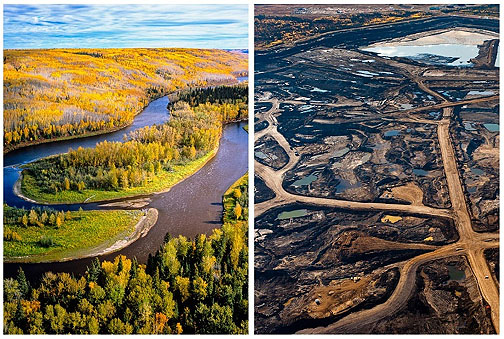
Tar Sands oil extraction: before and after. Photo: David Bergman, from Ecooptimism.
The fight against extreme energy extraction, now ongoing in hundreds of communities across the United States and the world, expanded to include another significant victory on Monday night in the town of South Portland, Maine. Townspeople and Maine environmental groups organized a “relentless 18-month campaign,” as the Los Angeles Times put it, resulting in a near-unanimous City Council vote (6-1) passing a Clear Skies Ordinance preventing the export of crude oil from South Portland’s waterfront.
The new Maine victory follows upon the use of tactics as diverse as tree-sits, nonviolent direct action blockades, massive marches on Washington, and even a blockade of the Douglas Channel in British Columbia made of yarn knit by members of the indigenous Gitga’at Nation. In particular, activists from Texas to Maine, from Nebraska to British Columbia, are expanding their tactical toolkit — now including this old-fashioned community organizing win — in campaigns to stop pipelines from exporting dirty, climate-destroying oil from the tar sands of Alberta, Canada.

Tar Sands Blockade: “Spectacular Aerial Tree Blockade Halts Construction in Solidarity with Idle No More First Nations Movement.” Photo: tarsandsblockade.org
In “Maine Town Fights Plan to Use Pipeline to Export Oil Sands Crude,” the Los Angeles Times captured the significance of the Maine battlefront, and the atmosphere in South Portland, right before Monday night’s vote:
Tom Blake, like thousands of his neighbors in this coastal town, is used to living alongside the oil industry. Tank farms cluster in neighborhoods, by the park where families watch the movie “Frozen” on a summer night, next to schools and senior citizens apartment buildings. As a child, Blake, the town’s former mayor, used to jump into high snow drifts from the massive oil tank next door.
Now, after decades as a New England hub for importing crude oil and distributing fuel, South Portland is enmeshed in a dispute with the oil industry that echoes far beyond southern Maine.
On Monday night, the South Portland City Council, including Blake, is expected to pass an ordinance that would prevent the export of crude oil from the waterfront. The product of a relentless 18-month campaign by residents and Maine environmental groups, the measure is a response to plans by Portland-Montreal Pipe Line, or PMPL, to reverse the flow of its import pipeline in order to export oil sands crude from Canada, the same petroleum that would run through the controversial Keystone XL pipeline in the Great Plains.
“This isn’t an anti-Portland pipeline company measure,” Blake said. “It’s anti-dirty oil.”
Maine State Representative Diane Russell (D- Portland) sent an email to Moveon members describing the victory, framing it as “one hell of a punch,” but warning that the struggle isn’t over.
Protecting Our Waters is publishing Rep. Russell’s email in full below, for several reasons. First, because the South Portland victory is a critical one in the particular fight against tar sands oil extraction. Second, because a victory against a new fossil fuel export pipeline anywhere is a victory — and a model — for fights against fossil fuel export pipelines everywhere. Third, because the South Portland City Council vote increases the positive cumulative impact of the current string of wins against extreme energy extraction, from the Pennsylvania Supreme Court decision overturning the core of Act 13, to the New York high court upholding the Dryden and Middlefield fracking bans. Finally, amidst the sheer effort of it all, one of the best antidotes to burnout is to fully observe, understand, and celebrate every victory along the way. So here is Rep. Russell’s summary:

Rep. Diane Russell. Photo: DianeRussell.com, from Huffington Post.
Last night, a small Maine town delivered one hell of a punch to people who support transporting Tar Sands oil from Canada. Let me give you a little history on this remarkable victory.
I live right on Casco Bay, a beautiful ocean vista, home to a vibrant working waterfront. The Fore River empties into the bay and provides the deepest port on the East Coast, meaning ships and freighters routinely deliver or pick up goods. South Portland sits on the other side of the Fore River, just across the bridge. In addition to having its own vibrant working waterfront, South Portland is the end point to a gas pipeline that currently sends crude oil north to Canada. People are concerned that one day, that pipeline will be reversed and Tar Sands oil will be transported South, endangering our air quality and Casco Bay.
It’s important to know that South Portland is essential if crude oil ever is to be piped to the East Coast as it’s the exit to the only pipeline coming from Canada on the East Coast. And, the East Coast is by far the highest population density. The very fact that so much money was spent on this otherwise minor, small town referendum, demonstrates just how essential it is to access that pipeline, and just how real concerns are that the direction of the pipeline could be reversed.
Last year, citizens collected petitions to place an ordinance on the ballot. Although there are currently NO plans to reverse the course of the pipeline, this small ordinance referendum in a small coastal town found itself at the heart of the Tar Sands battle. In fact, more than $600,000 was spent on the election. Environmentally sensitive voters lost that referendum by a very slim margin. Immediately after the election last November, the City Council placed a one-year moratorium on importing Canadian crude oil while it studied the matter.
Last night, after months of testimony and work, hundreds of people showed up to a City Council hearing in support of the new proposed Clear Skies Ordinance. The effort was worth it because the City Council voted 6-1 in support of zoning changes that will block the potential export of Canadian crude oil through their end of the pipeline. This was a huge victory, and demonstrates clearly the power of individuals who stand up for the safety of their town.
The fight’s not over; industry representatives are already planning to collect signatures to repeal the City Council decision, but for now environmentally concerned people have won a remarkable victory.
Follow the play-by-play on Twitter at #SoPoME ~ and I’ve included some relevant articles. Feel free to share widely!
- LA Times: Maine town fights plan to use pipeline to export oil sands crude
- Portland Press Herald:South Portland Approves Law Barring Tar Sands Oil
- Bangor Daily News: South Portland council casts ‘historic’ vote to block tar sands exports
Keep up the fight!
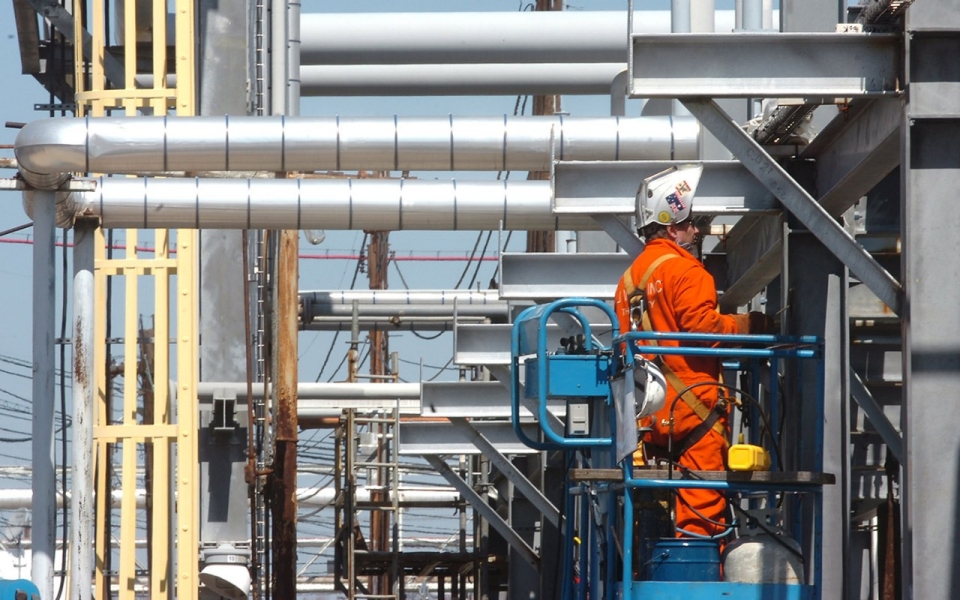
A worker builds part of the Mariner East pipeline, which is at the heart of a controversy over Sunoco’s attempt to use eminent domain and skirt local zoning laws. Photo: Julia Wilkinson / Delaware County Daily Times
Of all the biggest environmental news stories breaking right now, the Al Jazeera coverage of the Mariner East pipelines — the ones Sunoco Logistics is aggressively trying to ram through Pennsylvania to export fracked gas from the Marcellus Shale to Europe and Asia — is the biggest breakthrough.
You can cut straight to the story, “The gas company that says it can take your back yard,” here. Now. And read it straight through, while thinking about what you can do to stop the Mariner East pipeline(s). Or check out this overview and excerpts first.
The reporter, Evan C. Hill, covers in considerable detail the manipulative way Sunoco Logistics has bullied Pennsylvanians trying to hold onto their land. Some of those who began resisting Sunoco Logistics’ Mariner East Pipeline early on, are still resisting. Some gave way in the face of Sunoco’s enticements, pressure, threats and persistence.
But more are joining in the resistance, from grassroots organizers to high-powered lawyers, every day.
The story is well written. It’s complete, from the bigger picture of pipelines overall to Sunoco Logistics and Range Resources’ export plan, right down to the particular pump station in Chester County which is, so far, generating the most resistance. The author has done his homework.
SUNOCO LOGISTICS: “The gas company that says it can take your back yard”
Here’s the opener:
NORTH STRABANE, Pa. — For more than a decade, the country around Ronald and Sallie Cox’s home, 25 miles south of Pittsburgh, has been an unchanging landscape of rolling green foothills. Sitting atop a modest promontory, their property is ringed on three sides by a border of woodland, and to the east, the ground slopes down into a neighbor’s horse paddocks.
The Coxes built their home in 2001, and they’ve paid to maintain their enviable slice of exurban Pennsylvania. When Ronald, a financial adviser at Prudential, grew fed up with the way his wraparound backyard deck shifted every time he sat down for an evening drink, he spent around $30,000 to rip it out and replace it. You could probably land a plane on the new one, he jokes.
“This is my house, it’s my safe zone; nobody’s going to bother me,” he says. “It was worth it for the peace of mind.”
But in late 2012, someone bothered the Coxes. A representative of oil and gas transporter Sunoco Logistics Partners — a “landsman” sent by the company to scout and buy access to their property — came to their front door and told them that Sunoco was going to dig a pipeline under their woods.
“And I went: ‘No you’re not,’” Cox says.
Here’s its political middle, with a fantastic quote from PA state senator Andy Dinniman (emphasis added):
Perhaps more importantly, Sunoco’s gambit for public utility status and the ensuing legal battle, which is likely to play out for months and could involve the state’s appellate courts, may determine whether other private energy companies pursue a similar strategy in the future, potentially accelerating the development that has already altered the physical and economic landscape of the country’s gas-rich states.
“If Sunoco wins its case, we’ll have even less ability for questions involving [pipe]lines within the state,” says Andy Dinniman, a three-time Democratic state senator whose district is laced with pipelines and who has pushed for more oversight and transparency in the industry. “What it’s really going to turn out to be is the political muscle and political contribution muscle of the Marcellus Shale industry versus a larger and larger citizen protest, and I just hope the citizens win.”
And here is, not its end, but the core of what it exposes: While Sunoco Logistics has tried to shift strategy in order to appear “as if” they are transporting fracked gas from the shalefields of western Pennsylvania for “public benefit,” the wolf is still in sheep’s clothing. It’s exports, all the way:
In the months after the Mariner East project began, both Sunoco and Range Resources, a Texas-based drilling company that has agreed to provide 40,000 barrels of gas per day to Sunoco, said they expected to ship at least half of their wet gas to hungry markets in Europe. Range signed a 15-year contract with INEOS, a Swiss petrochemical producer, for its ethane.
But after the wave of resistance this spring, Sunoco appeared to shift its strategy. The company dropped its legal team, from the Harrisburg-based firm McNees Wallace & Nurick, and hired new attorneys from Philadelphia-based Blank Rome.
The new lawyers filed an amended petition in May, pointedly stating that Sunoco now intended to ship at least 5,000 barrels of propane per day — roughly 7 percent of the project’s capacity — to a destination in Pennsylvania before it reaches the Marcus Hook refinery and export terminal.
The change in plans was aimed at meeting “heightened demand…that arose from severe supply shortages” over the past winter, Sunoco wrote.
But lawyers and other Sunoco critics have dismissed the promise as a meaningless gimmick, not least because they doubt that the Mariner pipelines could siphon propane out of the liquid gas mix that early in the process, before reaching the terminal.
It also seems likely that export remains on Sunoco’s mind.
During a conference call with financial analysts in early May to discuss Sunoco Logistics Partners’ first-quarter performance, CEO Michael Hennigan said that a new plan by a competitor to build an ethane plant in Texas “shows that ethane is gonna export from the Gulf Coast” and reinforces “the thesis that we’ve been saying, [which] is that the barrels that are up in the Marcellus and Utica [shales] should really get to the European and Asian markets at the closest possible port.” Sunoco’s plan to pipe wet gas to its facility at Marcus Hook was a competitive way to do so, he said.
So don’t rest easy without reading all of this incredibly important expose about Sunoco Logistics, pipelines, everything you ever wanted to know about “wet gas,” the dangers of ethane and propane pipeline explosions, and the growing resistance — read it at the source. The Gas Company that Says it Can Take Your Back Yard.
Whatever you do, don’t let Sunoco Logistics actually take your back yard. Because everyone’s back yard is connected. And because this is what an exploding natural gas liquids pipeline actually looks like:

Huge fire from Aug. 12, 2013 pipeline explosion in Erie, Ill. could be seen from miles away WHBF-TV
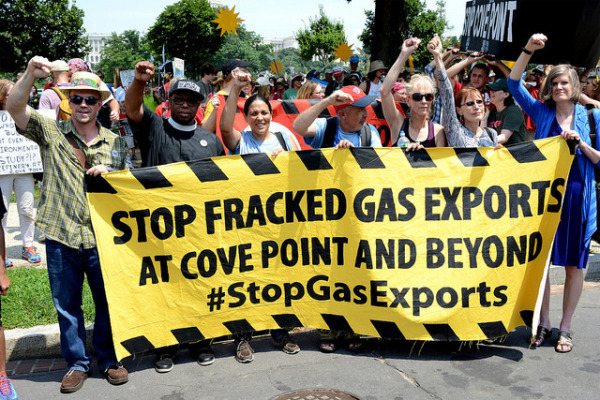
Marching in DC: Banner held by Tim DeChristopher, Rev Lennox Yearwood, Cherri Foyntlin on the left and Sandra Steingraber on the right. Photo: Chesapeake Climate Action Network
Activists March on Obama Energy Commission to Demand a Halt to Fracked Gas Exports
Chants of ‘Stop Cove Point’ echo through the streets of Washington, D.C. as federal regulators weigh the first proposed East Coast LNG export terminal
WASHINGTON, DC—Anti-fracking and climate activists from across the Mid-Atlantic region and beyond joined a first-ever “people’s march” on the Federal Energy Regulatory Commission (FERC) Sunday afternoon to protest the gas industry’s push to export liquefied natural gas (LNG) from U.S. coastlines. With a key decision nearing on the Cove Point export terminal proposed in Lusby, Md., just 50 miles south of the White House, protesters are calling on President Obama and FERC to halt approval of all LNG export projects and instead promote true clean energy solutions.
“We’re here today to stand up for clean air, drinking water and real solutions to the climate crisis,” said Sandra Steingraber, PhD, New York-based biologist, author, and science advisor to Americans Against Fracking. “With LNG exports, the only things Americans get are terrifying new health and safety threats, worsening climate instability, and higher heating bills, all so that the gas industry can make bigger profits from fracking us.”
Sunday’s protest united well over a thousand people from New York to Maryland to Louisiana, including many who would see firsthand impacts from the gas industry’s proposed export build-out. The rally began near the U.S. Capitol and culminated with a mile-long march to the doorstep of FERC. Marchers carried a 100-foot-long “Stop Cove Point” pipeline prop and giant banners depicting the chain of harmful impacts that proposed LNG export terminals would trigger—from expanded fracking wells to new pipelines and compressor stations to enormous amounts of planet-warming pollution.
Speakers repeated a common theme: FERC is endangering public safety and undermining President Obama’s own climate action plan by moving to rubber-stamp LNG export projects without comprehensive reviews of their human health or environmental impacts.
“For far too long, FERC has served as a facilitator for the oil and gas industry, rather than a regulator for the public good,” said Craig Stevens, a sixth-generation landowner Silver Lake Township, Pa., who has disaster blowouts in his backyard creek from pipeline installation, and water, air and land contamination. “Private drilling corporations, private pipeline companies, and now private LNG facilities make all the money, while people suffer the consequences.”
“President Obama can’t solve the climate crisis while overseeing a massive expansion of fracked gas infrastructure,” said Tim DeChristopher, a climate activist who served two years in prison for non-violently disrupting an illegal oil and gas auction on public lands in Utah in 2008. “As long as our political leaders continue to fail to offer an energy plan that is appropriate for the climate crisis, we have to resist every new project that would lock us into decades of more dependence on fossil fuels.”
Signs in the crowd reading “Obama: Gas Exports = Worse than Coal,” echoed findings of accumulating studies—including by the U.S. Department of Energy—that exporting fracked gas from the U.S. to Asia would likely be worse for the climate than if Asian countries burned their own coal. Yet FERC has refused to account for this data in its environmental reviews of the Cove Point facility and two LNG export projects recently approved in Louisiana. This omission could serve as one of many potential grounds for lawsuits.
“We’re here today to deliver a ‘people’s’ environmental impact statement to President Obama and FERC,” said Rev. Lennox Yearwood, Jr., CEO of the Hip Hop Caucus. “Any project that makes climate change significantly worse has no place on a livable planet, from Cove Point to Keystone XL. No matter what FERC decides in the near-term, the people will triumph in the long-term. We’ll keep fighting until wind turbines and solar panels crisscross our coastlines, and LNG facilities like Cove Point are defunct monuments to a dinosaur industry.”
The Cove Point terminal, one of 14 under FERC review, has faced particularly fierce opposition because it would be the first on the East Coast, threatening to drain massive pools of gas from the Marcellus shale region for export to Asia, where it fetches higher prices. The $3.8 billion facility, proposed by Dominion Resources, would also be the first gas liquefaction plant ever built directly next to a densely populated residential neighborhood. Hundreds of homes are in the potential “consequence zone” for fire and explosion catastrophes. During a recent public comment period, more than 150,000 comments were submitted to FERC opposing the project.
Rachel Heinhorst, a mother of three and teacher from Lusby who lives in the home closest to the Cove Point site addressed the crowd on Sunday. “I know money is the power behind this project,” said Heinhorst. “But what about my family, and families who have already lost lives or been displaced because of gas terminals like the one Dominion desires? FERC and President Obama, please hear us. We do not deserve to live in fear of an explosion, of the water we drink, of the air we breathe.”
Yesterday’s rally is part of a swell of grassroots activism that has emerged in recent years to resist fracking, and to challenge Obama administration policies that support it. Many in Sunday’s crowd have already faced the toxic impacts of fracking, or are actively fighting unwanted pipelines or compressor stations in their towns. They vowed to continue the fight to hold their political leaders accountable.
“Here in the Gulf, we know all too well the meaning of the word ‘sacrifice.’ Our families, our ecosystems, our life-sustaining waters, have been the lamb at the altar of these ruthless industries for far too long,” said Cherri Foytlin, author, advocate, speaker and mother of six, who works for climate justice in South Louisiana. “The end to this ritual is what the president holds in his hands. Will he divest his support from these greedy industries of the past, and help us invest in a viable future for generations yet to come?”
More than 40 national, state and community-based groups endorsed the July 13th rally. Organizing groups included Berks Gas Truth, Catskill Citizens for Safe Energy, the Chesapeake Climate Action Network, the Delaware Riverkeeper Network, Energy Action Coalition, Environmental Action, Earthworks, Food & Water Watch, Greenpeace, Public Citizen, the Sierra Club, Waterkeepers Chesapeake, and 350.
Kate Fried, 202-683-4905, kfried@fwwatch.org
“Our Refinery Is the Problem”: Philadelphia Protests Oil Bomb Trains, Honors Lac-Megantic
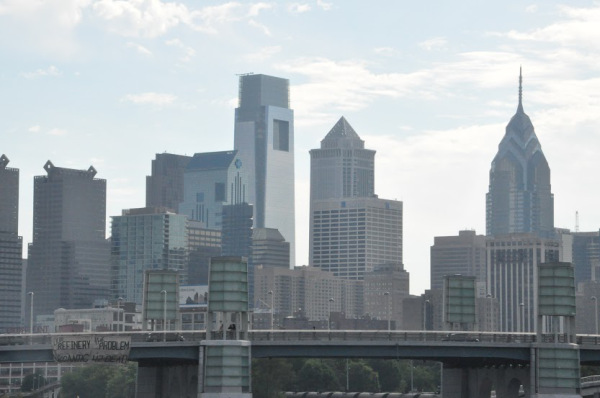
“Our Refinery Is The Problem” banner hangs from Philadelphia’s South Street Bridge on July 9, 2014 during national Oil Trains Week of Action.
Philadelphians Say NO to Oil Trains As Canadians Lost in Derailment Disaster Last Year Are Remembered
Councilman Curtis Jones and Residents Call for Change and Protection
Philadelphia, PA – Activists gathered today along the train tracks adjacent to the Schuylkill River in Philadelphia to call for protection of local communities, clean air and water supplies from dangerous oil trains that barrel through the City every day.
A moment of silence and the reading of the names of the 47 people who died in Lac-Mégantic, Quebec, a year ago in a fiery train accident marked the opening of the program with a message that the City must not suffer the same fate. After speakers were heard, the group marched through the Park, led by people representing each of the 47 lives lost.
Speakers included: Reverend Stephen Keiser; Tracy Carluccio, Delaware Riverkeeper Network; Mary Donahue, Clean Water Action; Jess Gould, West Passyunk Neighbors Association; Kevin Poole, Northeast Grays Ferry Residents Association, Inc.; and Philadelphia City Councilman Curtis Jones, Jr.
The group staged their event at the Schuylkill Banks Trail Park at 25th and Locust Streets next to the rails used by CSX Corporation for transporting 190,000 barrels of crude oil every day to Philadelphia Energy Solutions’ (PES) refinery in South Philadelphia.
In January of this year, seven cars of a CSX train derailed on the Schuylkill Arsenal Railroad Bridge, leaving an oil tank car dangling over the Schuylkill River for a week, a major catastrophe narrowly averted. Accidents occur regularly throughout the U.S., escalating with the production of Bakken shale oil from North Dakota. In fact, more oil was spilled in rail accidents in the U.S. last year than in the previous 4 decades, according to federal statistics.
And yet safety and emergency preparedness is lagging terribly behind the ramp up in domestic oil extraction. PES and CSX Corporation plan to expand crude-by-rail through Philadelphia by 50% before the end of the year, making Philadelphia more vulnerable than ever to disaster.
Mile-long trains rumble through the City’s neighborhoods, over the river on the Schuylkill Arsenal Railroad Bridge and the crumbling 25th Street Bridge without warning twice a day – the train schedule is kept secret for “security reasons”, according to Emergency Management officials.
Councilman Curtis Jones, Jr. spoke about the dangers for City residents and the importance of preventing catastrophe in Philadelphia. Pastor Stephen Keiser memorialized those lost in Quebec and neighborhood organizations and environmental groups spoke of the need to stop allowing the oil companies to serve their needs above the public’s.
Organizers of the event, a coalition of local groups (see list below), are calling for the dangerous trains through the populated City to stop, for effective emergency preparedness and the release and dissemination of critical emergency response information to the people of Philadelphia, and for sweeping change of oil transport at the federal regulatory level.
For instance, a petition is being circulated calling for a ban of the outdated and unsafe DOT111 tank cars known as “Pepsi cans on wheels” which are known to puncture and explode due to substandard construction and the high volatility of Bakken crude oil.
The groups are advocating for fossil fuels to be replaced by clean, renewable and energy efficient power sources. The event is part of a national Week of Action exposing a myriad of crude-by-rail problems with the ultimate message “Keep oil off the rails and in the ground”. (www.stopoiltrains.org)
“What is truly evil about the train disaster in Lac-Mégantic is the fact that this disaster could have been prevented if human life and safety were valued as highly as maximum profits. The derailment of an oil tanker over the Schuylkill River in January should alarm every Philadelphian and make us realize that what happened in Quebec last year could very easily have happened here. Pennsylvania has the resources to ensure that energy can be produced and transported safely, without catastrophic risk,” said Stephen Keiser, Pastor, Lutheran Church of the Holy Communion, Philadelphia.
“There is a growing awareness of the crude oil that CSX trains are carrying through our neighborhoods at an increasing rate. We cannot ignore the harm and loss of life that other crude oil derailments have caused across the U.S. and Canada. It is by shear fate that no one has been seriously injured. It is only a matter of time. We are scared and much must be done to assure our safety and alleviate our fears,” said Jessica Gould, President of West Passyunk Neighbors Association.
“We don’t have to look far to see the kinds of derailments occurring and what they can do to destabilize neighborhoods and communities. Whether it’s in Delaware or New Jersey or Pennsylvania, we have seen recent instances when accidents happen and they have unintended consequences that are drastic and long term for communities,” said Curtis Jones, Jr., Philadelphia City Councilman.
“Because of the recent immense influx of crude-by-rail transportation on this aging infrastructure in Philadelphia, we’re concerned about the ability of the rail network to handle it, and our city’s ability to prepare for and respond to an accident. It is only a matter of time before the City is tested with a disastrous derailment,” said Mary Donahue, Program Organizer with Clean Water Action.
“Philadelphia gets a double whammy from shale oil because layered on top of the risk of exploding tank cars, emergency evacuations, and air and water pollution these oil trains bring polluting fossil fuel to the refineries, terminals, and ports that make up the Philly Frack Hub. These menacing oil trains have got to be stopped and families and community health put first,” said Tracy Carluccio, Deputy Director, Delaware Riverkeeper Network.
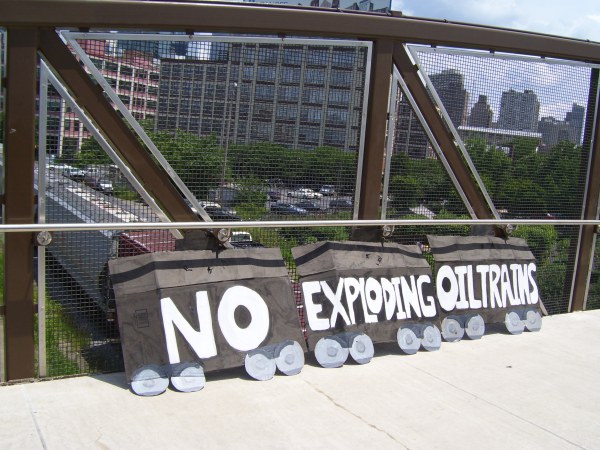
“No Exploding Oil Trains” banner displayed as shale oil train passes by the morning of Philadelphia oil trains action, July 9 2014. Photo: Ann Dixon
“The people of Pennsylvania have a constitutional right to clean air and clean water. God forbid a derailment happens; it would be the sum of all fears for communities here. CSX has a responsibility to operate safely but the 25th Street Bridge is a crumbling hazard, along with other dangers. We need our quality of life, and our environmental and economic life in the City improved and people protected from these trains,” said Kevin Poole of Northeast Grays Ferry Residents Association.
“Ticking time-bombs should not be rolling by our schools and neighborhoods on a daily basis. We need to free ourselves from our fatal addiction to fossil fuel, whether it’s carried by oil-bomb trains or pipelines. Another world is possible, a just, ecologically sustainable world, but we can’t build it on a dead planet”, said Cynthia Bertrand Holub of Rising Tide Philly.
“Our local, state, and federal officials have an absolute obligation to protect us from the lethal threat and from the toxic spills into our waterways, from shale oil and gas ‘bomb trains.’ We join in protest and outrage, and remain committed to hold decision-makers’ feet to the fire until residents’ water, air, and climate are protected, the bomb trains halted, and a safe energy economy is built,” said Iris Marie Bloom, Founder, Protecting Our Waters.
Groups participating in the event include (alphabetical order):
Clean Water Action (CWA) is a million member national environmental organization with 17 statewide offices including Pennsylvania. CWA’s mission is to protect the environment, public health, economic well being, and community quality of life. http://www.cleanwateraction.org/pa
Delaware Riverkeeper Network is a nonprofit advocacy organization with 15,000 members throughout the watershed states working to defend the entire 13,539 square mile Delaware River Watershed. http://www.delawareriverkeeper.org
Northeast Grays Ferry Residents Association, Inc. is a registered 501 c3 nonprofit organization that believes in equal opportunity, public health and safety, economic development and fights poverty to enhance the quality of life for the people of Northeast Grays Ferry.
Philadelphia Interfaith Power and Light (Phila IPL) is a Chapter of Pennsylvania Interfaith Power and Light (PA/IPL), communities of faith responding to climate change as a moral issue.
Protecting Our Waters, a Marcellus Shale regional grassroots group with a strong base in Philadelphia, fights to protect water, air, public health, climate and communities from all phases of shale gas and oil extraction, processing, transportation and use. www.protectingourwaters.com
Rising Tide is a grassroots network of unpaid activists focused on direct action targeting the funders and profiteers of dirty energy projects. https://www.facebook.com/PhillyRisingTide
South Philadelphia Rainbow Committee is a grassroots community group in Southwest Philadelphia, concerned with bringing an overall sense of security and self-awareness to the City of Philadelphia.
West Passyunk Neighbors Association is working to strengthen our community and improve our neighborhood’s way of life, 18th to 25th, Passyunk to Mifflin https://www.facebook.com/wpnaphilly
Press may contact:
Tracy Carluccio
Deputy Director
Delaware Riverkeeper Network
Phone: 215-369-1188 x 104
Email: tracy@delawareriverkeeper.org
Mary Donahue
Program Organizer
Clean Water Action
Phone: 215-545-0250 x 206
Email: mdonahue@cleanwater.org


